 You can never have too much free music! Head on over to musictechtips.wordpress.com and check out this post: 11 Best Free Sheet Music Sites. It is an excellent list of sites that contain free pdfs of sheet music. A word of caution: not all free sheet music online is copyright free. Always be careful to observe copyright restrictions, if any.
You can never have too much free music! Head on over to musictechtips.wordpress.com and check out this post: 11 Best Free Sheet Music Sites. It is an excellent list of sites that contain free pdfs of sheet music. A word of caution: not all free sheet music online is copyright free. Always be careful to observe copyright restrictions, if any.
Category: Resources
Teacher Resources @ Clavier’s Piano Explorer site
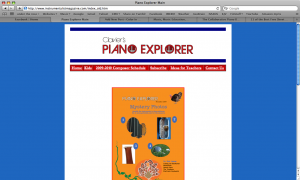 Many piano teachers subscribe to Clavier magazine, and some even subscribe their students to Clavier’s Piano Explorer, the music magazine for kids. I recently found out that their site contains some great resources for teaching about various composers and concepts in music history. This month, there have some great resources about Beethoven, including:
Many piano teachers subscribe to Clavier magazine, and some even subscribe their students to Clavier’s Piano Explorer, the music magazine for kids. I recently found out that their site contains some great resources for teaching about various composers and concepts in music history. This month, there have some great resources about Beethoven, including:
- Links to YouTube recordings, organized by Beethoven’s early, middle, and late compositional periods – click here and scroll down.
- A pdf worksheet about sonata form, to be filled out while listening to Beethoven’s Pathetique Sonata – click here and click “pdf” under Sonata Form.
These resources would be perfect for a summer camp or a group lesson!
Piano makes taking the stairs more fun!
Here’s a fun idea for making the stairs more fun to use! Watch the video below:
6 Ways for Teachers to Stay Current
Although many of us teachers are no longer in college, I think it’s safe to say that we all want to stay connected with other teachers/musicians and continue to improve and grow both as teachers and musicians. Here are six ways to do just that:
- Stay in touch with any previous teachers or professors you may have had in the past. Email is a great means to do so, as well as Facebook (it’s not just for the young folks anymore!). Ask questions or ask for suggestions, and exchange teaching ideas. You can never have too many resources. It’s important to keep past contacts fresh.
- Join a formal organization such as MTNA or Piano Guild. By attending meetings and entering students in their events, you will invariably meet new fellow teachers and make new friends. In addition, by attending lectures, you will be furthering your education as a teacher/musician.
- Join forces with fellow piano teachers in your area and hold a summer piano camp or a Christmas Party/Recital together. Be sure to keep it fun and non-competitive, and never try to “steal” students from another teacher.
- Subscribe to blogs of other piano teachers. There are thousands of other teachers out there just like you, with ideas and resources to share with you. The internet holds a wealth of information just waiting to be found. Once you find a few sites you’d like to regularly follow, subscribe to their sites via email (you’ll receive an email each day that they post new content) or via a feed reader. A feed reader is a free service that allows you to read the latest content of all your favorite blogs all in one place.
- Start your own blog (separate from your studio website). Share your ideas and expertise with other teachers by posting articles about various topics and putting up any worksheets or other materials you have made in the past. Both Blogger.com and WordPress.com allow you to make and maintain a blog for free. (If you want your own domain name, you will have to buy one, however.)
- Participate in online forums. There are a number of sites that have forums, such as the Piano Club Forum on the Fabers’ pianoteaching.com website. In addition, you can join a Yahoo group such as piano_teacher_support and talk with other piano teachers about any topic under the sun.
Do you have other ways you stay connected? Let us know by sharing below!
What Motivates Musicians and Music Students? – Part 1
I found an interesting post over at the Third-Stream Music Education blog. It includes a link to a fascinating video of Dan Pink’s presentation about motivation in the business world (be sure to watch the whole thing!). The post at the Third-Stream Music Ed blog makes some interesting connections between ways of motivating employees and ways of motivating students in music education settings in schools.
There are some connections here that can made made to private piano teaching as well. Knowing what we do about how motivation works, how can we effectively motivate our students? How can we improve the number of students who quit piano by the time they reach junior high and high school? What kind of incentive program should we create in our piano studios in order to get maximum results from our students?
But first — here are two of Dan Pink’s basic propositions:
- When the solution is clear and the tools needed to complete the problem are provided, extrinsic motivations (such as, a monetary bonus) work very well to encourage productivity from employees. It’s the whole follow-the-carrot kind of reward system.
- But when the solution is less obvious and the tools may not be provided, monetary motivations do not work well. Instead, intrinsic motivators (i.e., being motivated by the feeling that what you do matters) work well. Intrinsic motivators work better for situations where the problems require creative, innovative solutions and “thinking outside the box” is needed.
The teaching and learning of music falls into the second category, because it is so subjective and it requires creative problem-solving skills. And so, according to Pink, intrinsic motivators then ought to be used.
Before we talk about the application to incentive programs, let’s first clarify what the “tasks” or goals of learning piano (or music in general) are: mastery of the instrument. But what does this “mastery” involve? At first appearance, our goal seems to get our students to play play their pieces accurately, with few mistakes. Under this definition of mastery, a robot could conceivably succeed. Well, then maybe mastery is to get out students to progress rapidly, or to play lots of difficult repertoire. According to this logic, a “successful” music educator would be one who has students who learn all of 32 Beethoven piano sonatas, or who become concert pianists, perhaps. While, or course, these things are not bad, they aren’t exactly our goal either. At least, not our chief goal.
So then what is our chief goal? We want them to create music — music that carries meaning and touches the emotions. In other words, we want our students to become masters at creating musical meaning and communicating emotions through their music. And if they become concert pianists along the way, so be it. But I’d say we’ve succeeded as soon as we create individuals who can appreciate music as a way of communicating expression. This is something that all of our students — both the talented and less so — can attain, at some level. This is much more practical than trying to create concert pianists. And so much more rewarding.
This goal in itself is an intrinsic motivator, for even the youngest of students can appreciate the value of musical meaning and feel important as they learn to create musical meaning. But to encourage this kind of mastery of the instrument, we need to make sure that our incentive programs are reflecting this goal.
[…to be continued in Part 2…]
Using Adjectives to Capture the Imagination
One of the ideas I’ve been exploring extensively throughout the research I’m doing for my paper for college (the one about improvisation) is making music musical. This seems so obvious, but really, what would music be without musicality? Check out this video, of a robot playing the violin.
Speaking of which, have you ever had students who played like robots? ***raises hand timidly*** Yep, I have too. This is what music would be like without musicality.
What started me thinking of robots, and music, and robotic students, you may ask? Well, I came across a lovely resource over at The Piano Pedagogy Page — a handy list of adjectives.
It may seem that a list of adjectives may be more fitting for use in an English class. Maybe. But it may also be helpful in the piano lesson, in helping those certain robotic-like students get “beyond the notes.” Shoot, it might even be good reminder for me from time to time! It’s easy to fall into the trap of being overly concerning with the technique, and fail to think about what I consider to be the ultimate goal of music: to communicate expression. Music is meant to reach out and speak to people, at one level or another.
It’s so important to be teaching students musicality at an early age. It makes lessons so much more exciting, anyway. We are not trying to create little robots who can push the right buttons (i.e., the keys on the piano) at the right time, but creating little music makers.
@ PrimaMusic.com – 25% off Music Gifts
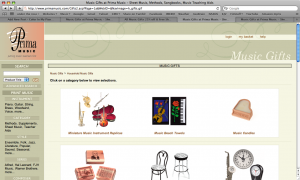
For those of you teachers who are already thinking ahead to Christmas time, head on over to PrimaMusic.com, where they are offering a special 25% off sale on all music gifts for the next two weeks. As always, shipping is free. PrimaMusic has one of the largest online selections of music gifts I’ve seen. Be sure to check it out!
My Favs: Jim Brickman solo piano music
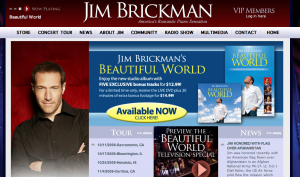 In a post last week, I mentioned Jim Brickman — composer of new age solo piano music (as well as some pop music with vocals). His music is great to play when you are stressed out and just want to play something relaxing that doesn’t require as much concentration as classical music. =D I thought I’d share some of my favorites among his compositions.
In a post last week, I mentioned Jim Brickman — composer of new age solo piano music (as well as some pop music with vocals). His music is great to play when you are stressed out and just want to play something relaxing that doesn’t require as much concentration as classical music. =D I thought I’d share some of my favorites among his compositions.
I own two books of sheet music by Jim Brickman. I enjoy playing his music at weddings and dinners. It’s perfect for occasions when you need to play something more contemporary and less formal than classical music. It also mixes well with hymn arrangements.
- One of the books I own is: Jim Brickman / Piano Anthology
. This book is a great value for the money. Some of his books of sheet music include pop songs that have vocal lines (such as the popular Christmas song, “The Gift” ). If you want to avoid those and stick to mostly solo piano music, this book is a great option. A couple great pieces included in this book are, “Angel Eyes” and “Rocket to the Moon.”
- My favorite of the two books that I own is: The Songs of Jim Brickman for Easy Piano: Piano Solos
. These selections have been arranged by Dan Coates, and are a little touch easier to play — not to mention they are easier on the hands! Jim Brickman must have large hands, because he likes to include lots of tenths in his LH accompaniment figures. =) So if you have small hands, this book is preferable over his original arrangements. This includes my all-time favorite Jim Brickman tune, “Serenade.”
You can visit his site here, to get more information and hear some recordings. I noticed on his site that he also has available a few books I’ve never seen before, but look very interesting:
- Simply Jim Brickman Songbook — are all arranged by Dan Coates, and appears to be a better value than the one I mentioned above.
- The Best New Wedding Classics — includes many of the same ones I use at weddings — again, a great bang for your buck.
Free piano arrangements of anime music
I recently received a new transfer adult student. She’s an excellent sight-reader and a fun person to be around! She has a great interest in anime (for those of you not familiar with anime [AH-nee-may], it is “a style of animation developed in Japan,” according to Answers.com). Shehas been teaching me quite a bit about anime and video game music. I think I am learning just as much from her as she is from me. =)
Evidently, there is a wealth of free piano arrangements of anime music themes online. The arrangements she has been working on (they are “just for fun” pieces, which accompany her classical repertoire, of course) basically sound like new age solo piano music (think Jim Brickman or George Winston). Below, I’m passing on a few links she shared with me:
- First, you’ve got to listen to this on YouTube: orchestral piece “Sadame” or “Destiny” from an anime movie — simply gorgeous!
- Check out this recording of “Sadame” for piano here, and then find the sheet music here (scroll down to the “Animes” section, and click the pdf icon for “Destiny – Sadame” ).
- Other sites for finding free anime sheet music can be found here, here, and here.
- It can seem overwhelming to browse through these anime sites, especially when you’re not sure what you are looking for. For me, it’s a whole new world within the sheet music realm! According to my student, anything from Final Fantasy, Naruto, and Inuyasha is good.
I hope you find this information helpful for any high-school or college-aged piano students you might have. Happy browsing!
free Renee Fleming download @ Amazon.com
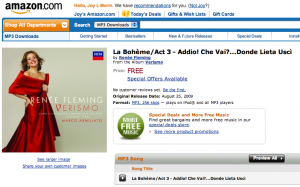 Run on over to Amazon.com! They currently are offering a free mp3 download of La Bohème/Act 3 – Addio! Che Vai?…Donde Lieta Uscì by the amazing Renee Fleming. It is not often that Amazon includes classical music among their selection of free mp3s, and it won’t last long. If you are a fan of opera music, especially by Renee Fleming, don’t pass up the chance to get this!
Run on over to Amazon.com! They currently are offering a free mp3 download of La Bohème/Act 3 – Addio! Che Vai?…Donde Lieta Uscì by the amazing Renee Fleming. It is not often that Amazon includes classical music among their selection of free mp3s, and it won’t last long. If you are a fan of opera music, especially by Renee Fleming, don’t pass up the chance to get this!
YouTube: Jammin’ on a Giant Piano
How many of us piano teachers (and students) would love to have one of THESE in our pianos studios?! The video below shows a couple of young professional foot piano players playing/dancing on a giant foot piano:
Want to buy one? They do indeed sell them — for just $250,000 apiece. Start saving!!
Check out listenlearnmusic.com
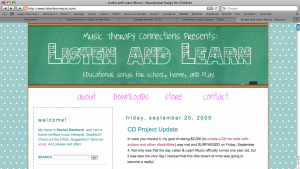 I recently discovered Rachel Rambach’s site: listenlearnmusic.com. Rachel is a board-certified music therapist, which means, she’s also a performer, educator, and composer, all wrapped into one. Through her blog, she shares the music she composes for other music educators to incorporate in their own music lessons.
I recently discovered Rachel Rambach’s site: listenlearnmusic.com. Rachel is a board-certified music therapist, which means, she’s also a performer, educator, and composer, all wrapped into one. Through her blog, she shares the music she composes for other music educators to incorporate in their own music lessons.
Recently, she’s been raising money for a cd project: to record and produce a cd of her original compositions to give to children with autism or other disabilities at no cost. She has reached her $2000 goal, however, each dollar she raises could = another cd that can be given to children! Be sure to check out her blog and her project by clicking here.






